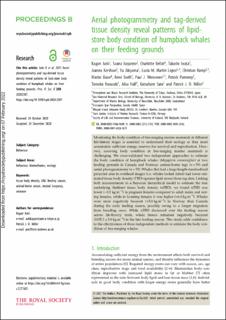| dc.contributor.author | Aoki, Kagari | |
| dc.contributor.author | Isojunno, Saana | |
| dc.contributor.author | Bellot, Charlotte | |
| dc.contributor.author | Iwata, Takashi | |
| dc.contributor.author | Kershaw, Joanna | |
| dc.contributor.author | Akiyama, Yu | |
| dc.contributor.author | Martín López, Lucía M. | |
| dc.contributor.author | Ramp, Christian | |
| dc.contributor.author | Biuw, Martin | |
| dc.contributor.author | Swift, René | |
| dc.contributor.author | Wensveen, Paul J. | |
| dc.contributor.author | Pomeroy, Patrick | |
| dc.contributor.author | Narazaki, Tomoko | |
| dc.contributor.author | Hall, Ailsa J. | |
| dc.contributor.author | Sato, Katsufumi | |
| dc.contributor.author | Miller, Patrick J.O. | |
| dc.date.accessioned | 2022-02-08T13:59:30Z | |
| dc.date.available | 2022-02-08T13:59:30Z | |
| dc.date.created | 2022-02-04T19:43:38Z | |
| dc.date.issued | 2021 | |
| dc.identifier.citation | Proceedings of the Royal Society of London. Biological Sciences. 2021, 288 (1943), . | en_US |
| dc.identifier.issn | 0962-8452 | |
| dc.identifier.uri | https://hdl.handle.net/11250/2977764 | |
| dc.description.abstract | Monitoring the body condition of free-ranging marine mammals at different life-history stages is essential to understand their ecology as they must accumulate sufficient energy reserves for survival and reproduction. However, assessing body condition in free-ranging marine mammals is challenging. We cross-validated two independent approaches to estimate the body condition of humpback whales (Megaptera novaeangliae) at two feeding grounds in Canada and Norway: animal-borne tags (n = 59) and aerial photogrammetry (n = 55). Whales that had a large length-standardized projected area in overhead images (i.e. whales looked fatter) had lower estimated tissue body density (TBD) (greater lipid stores) from tag data. Linking both measurements in a Bayesian hierarchical model to estimate the true underlying (hidden) tissue body density (uTBD), we found uTBD was lower (−3.5 kg m−3) in pregnant females compared to adult males and resting females, while in lactating females it was higher (+6.0 kg m−3). Whales were more negatively buoyant (+5.0 kg m−3) in Norway than Canada during the early feeding season, possibly owing to a longer migration from breeding areas. While uTBD decreased over the feeding season across life-history traits, whale tissues remained negatively buoyant (1035.3 ± 3.8 kg m−3) in the late feeding season. This study adds confidence to the effectiveness of these independent methods to estimate the body condition of free-ranging whales. | en_US |
| dc.language.iso | eng | en_US |
| dc.title | Aerial photogrammetry and tag-derived tissue density reveal patterns of lipid-store body condition of humpback whales on their feeding grounds | en_US |
| dc.type | Peer reviewed | en_US |
| dc.type | Journal article | en_US |
| dc.description.version | publishedVersion | en_US |
| dc.source.pagenumber | 0 | en_US |
| dc.source.volume | 288 | en_US |
| dc.source.journal | Proceedings of the Royal Society of London. Biological Sciences | en_US |
| dc.source.issue | 1943 | en_US |
| dc.identifier.doi | 10.1098/rspb.2020.2307 | |
| dc.identifier.cristin | 1998008 | |
| cristin.ispublished | true | |
| cristin.fulltext | original | |
| cristin.qualitycode | 2 | |
